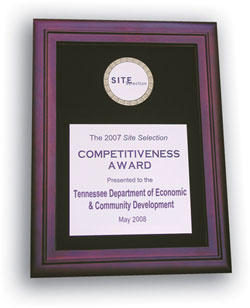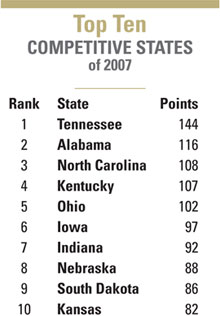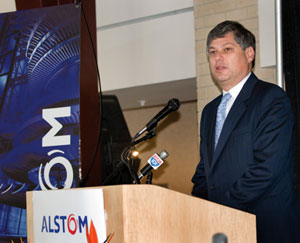
Performance
ennessee’s Department of Economic & Community Development has won handily – by a margin of nearly 30 points – the 2007 Site Selection Competitiveness Award. This is the department’s second such award since the index-based recognition was launched in 2003 for economic development activity in 2002.
The award goes to the state-level economic development agency that accumulates the most points across 10 criteria that measure business-expansion activity; the criteria are based on project data tracked by Site Selection publisher Conway Data’s proprietary New Plant database. To qualify in a given category, a state must finish in the top 20, at which point it is assigned points according to where in the top 20 it fell.
Among the 10 criteria used in the indexing system are four per-capita measures so that

states have the same shot at competing for the award. The criteria used are:
• Total new and expanded facilities per 1 million population in 2007;
• Total capital investment in new and expanded facilities per 1 million population in 2007;
• Total new jobs created at new and expanded facilities per 1 million population in 2007;
• Total actual number of new and expanded facilities in 2007;
• Percentage growth in new and expanded facilities from 2006 to 2007;
• Three-year growth change (from 2004 to 2007) in new and expanded facilities;
• Ranking in Site Selection‘s most recent annual business climate survey;
• Number of top 100 metros in the annual ranking of top metros;
• Number of top 100 small towns in the annual ranking of small towns; and
• Number of 100-plus-job projects per 1 million population in 2007.
Just how did Tennessee regain the top slot?
“Tennessee has worked hard in the last six years to make long-term, substantial changes that have greatly improved our overall business climate,” says Commissioner Matthew Kisber, who heads the Department of Economic & Community Development. Among the changes he cites are (1) reform of the state’s workers’ compensation program by bringing costs down and ensuring fair benefits to workers – a move that has yielded business more than US$250 million dollars in premium savings since the reforms were enacted in 2004; (2) creation of the Jobs Cabinet, which gives companies a single point of contact for all services, reduces red tape and mandates a 72-hour response to requests from companies regarding incentives; (3) retooling of incentives to give the commissioner of ECD broader latitude to meet companies’ needs, including expanded tax credits to cover pollution-control equipment, emerging industries and companies investing in rural communities; and (4) revamping of community-development programs to make Tennessee communities more competitive through strategic planning requirements with meaningful metrics.
“In terms of our incentive and program offerings, Tennessee’s competitive advantage comes in its ability to be flexible,” says Kisber. “Our offerings allow us to be creative in our proposals, giving us the opportunity to listen to the company, understand their individual needs and address them in a customized manner.”
Kisber also credits Gov. Phil Bredesen with making Tennessee more competitive. “Governor Bredesen is the former CEO of a publicly traded company, and he has taken his successful private-sector practices and put them to work for Tennessee,” he explains. “CEOs looking to do business in Tennessee understand they are working with a governor who understands their needs and their challenges and can work creatively to develop unique solutions in order to make projects happen, instead of taking a ‘one-size-fits-all’ approach.”
Creation of the Jobs Cabinet was one of Gov. Bredesen’s first actions in office. The Jobs Cabinet requires state agencies and other economic development groups in Tennessee to work as a team in job-creation efforts, cutting red tape and allowing Tennessee to create comprehensive and competitive proposals in a very timely and efficient manner.
“It is very common to see the ECD and Revenue Department teams present a proposal together, demonstrating this approach,” says Kisber. “Corporate executives have noted Tennessee’s unique ability to have leaders in charge of economic development and tax policy working together to speak with a consistent, unified voice.”
Where the state is situated is icing on the cake. “Our prime location and foothold on the logistics market are natural assets that make Tennessee very competitive,” Kisber points out. “More than three quarters of major markets in the U.S. are within a day’s drive of Tennessee, and Memphis is home to the world’s largest freight airport. Businesses who desire convenient access to their customers in the U.S. marketplace find Tennessee to be an ideal location.”

Dual Focus Areas
Two areas of particular interest to the governor and the state’s economic development team in 2007 were improving the business climate of rural areas and investing in work-force training.
“Analysis of our job growth demonstrated that urban and suburban counties were the prime beneficiaries of our efforts,” says Kisber. “With a mission statement of creating ‘higher skilled, better paying jobs for all Tennesseans,’ Governor Bredesen led in the creation of the Rural Opportunity Initiative (ROI), which focuses on three areas. First is the Rural Opportunity Fund. Managed by Southeast Community Capital, this $12-million dollar public/private fund can be used by businesses in rural Tennessee to expand and create new jobs, providing a source of capital in areas where capital is difficult to obtain.
“Second,” says Kisber, “is the ROI incentive, which creates an expanded category of tax credits for companies locating in rural communities with traditionally high unemployment. Depending on the county’s level of economic need, the additional tax credit can offset up to 100 percent of the company’s total Franchise and Excise Tax over and above the customary 15-year window.
“And third is the Orange Carpet Tours,” Kisber continues. “Tennessee ECD has partnered with a national site-selection consulting firm to tour rural communities, assess strengths and weaknesses, issue both written and verbal feedback and to help create an improvement plan aimed at making the communities more competitive in economic development.”
The second major focus area for the state in 2007 was to strengthen the investment in Tennessee’s work force.
“Business leaders continue to tell us that a ready and able work force is one of the most compelling assets a company considers when looking to expand or relocate,” says Kisber. “Under Governor Bredesen’s leadership, Tennessee has increased the funds available for worker training from just over $4 million in 2003 to more than $25 million in the current fiscal year. The primary vehicle for worker training is ECD’s Fast Track Job Training Assistance, which covers the cost of training new hires for a relocation project or worker skill upgrades for expanding companies. Despite a tight budget year in 2008-2009, Governor Bredesen has called for an increase in funding to Fast Track Job Training Assistance in the coming year.”
Two specific projects illustrate Tennessee’s competitiveness in 2007, says Kisber – Hydroserre and Alstom. (The latter is recognized as an Honorable Mention Top Deal of the Year in North America.)
“Tennessee competed heavily with a neighboring state for Hydroserre, a company that manufactures food products through hydroponic technology,” Kisber says. “The project was unique in that the company grows lettuce and is not considered traditional manufacturing. Our team convened members of the Department of Revenue, the TVA, the local chamber and the Upper Cumberland Electric Membership Corporation to create a customized incentive package that directly addressed their needs. Other factors that greatly influenced the decision were the availability of skilled labor in the area and the temperate climate which was conducive to growing their product. Hydroserre ultimately chose Livingston, Tenn., as its location. The project will create 291 new jobs and has a total investment of $40 million dollars in new investment to the state.
“Alstom, a global leader in power generation based in France, chose Chattanooga for a new manufacturing facility and a divisional headquarters,” Kisber continues. “The State of Tennessee, City of Chattanooga and Hamilton County worked together to secure the project that represents an investment in excess of $200 million and the creation of approximately 350 new jobs. Alstom will manufacture steam turbines, gas turbines, generators and related equipment for use in U.S. power-generation facilities. This will include manufacturing new steam turbines for fossil and nuclear applications, as well as retrofitting existing steam turbines with up-to-date technology. Chattanooga was chosen for its excellent transportation infrastructure, centralized location and highly skilled work force.” [See the SITE Visit report in the March 2008 issue of Site Selection – Ed.]
Can Tennessee win again this year?
Programs already are under way that will give it more than a fighting chance, Kisber points out.
These include a continued focus on execution of Gov. Bredesen’s ROI to stimulate job creation in rural areas, creating stronger communities and more vibrant local economies for all Tennessee citizens; creating strategic industry incentives to attract the types of industries to complement the Tennessee economy; and a focus on creating new jobs related to energy development and alternative fuels.
“Governor Bredesen created the Task Force on Energy Policy with the aim of developing recommendations for increasing energy efficiency in state government, developing a strategic energy policy for Tennessee and aligning Tennessee’s R&D resources – such as the University of Tennessee and Oak Ridge National Lab – to create innovative new products and businesses in the area of alternative and renewable fuels and to drive economic development through clean technologies,” Kisber explains.
Site Selection Online – The magazine of Corporate Real Estate Strategy and Area Economic Development.
©2008 Conway Data, Inc. All rights reserved. SiteNet data is from many sources and not warranted to be accurate or current.

